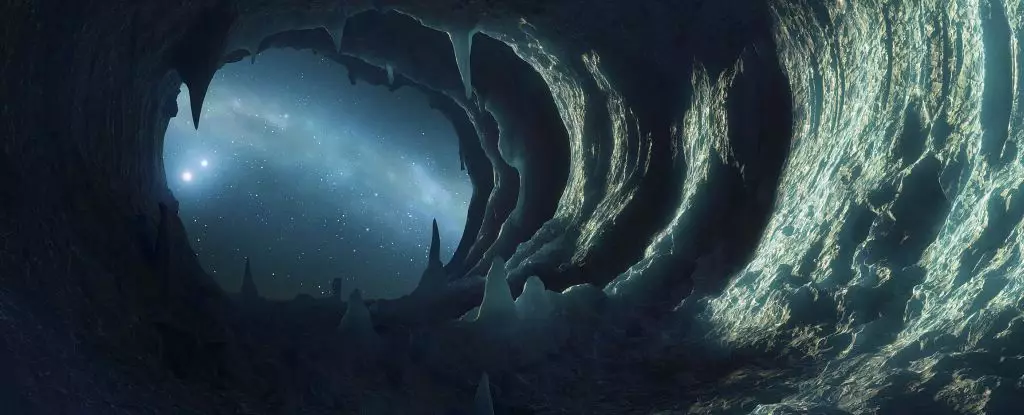For centuries, scientists have painted a simple picture of water freezing into a disordered, amorphous solid when exposed to the frigid emptiness of space. The prevailing assumption was that, unlike the crystalline ice familiar on Earth, space-bound ice remains an impassive, amorphous mass— a frozen chaos devoid of structure. However, recent exploratory research disrupts this narrative, revealing that cosmic ice could cloak a surprising amount of intricate order beneath its seemingly disordered exterior. This revelation does more than challenge existing models; it illuminates the subtle intricacies woven into the very fabric of space’s coldest realms, impacting our comprehension of planetary formation, galaxy evolution, and the fundamental behaviors of water itself.
This breakthrough arose from a meticulous combination of computer simulations and experimental validations, demonstrating that tiny, nanometer-scale crystalline clusters—embedded within the amorphous matrix—are likely a universal feature of extraterrestrial ice. Such structures, far from being negligible imperfections, could influence how water interacts with other cosmic materials and how energy is transferred across the universe. This newfound perspective shifts our understanding from viewing space ice as a disorganized frozen soup to recognizing it as a complex mosaic of order and chaos. It underscores that even in the vast, cold vacuum of space, subtle patterns persist, shaping the processes that underlie the cosmos.
The Myth of Purely Amorphous Space Ice
Historically, the idea of amorphous ice in space has been anchored in the understanding that extremely low temperatures prevent molecules from arranging themselves into crystalline structures. Think of water vapor depositing onto cold surfaces—-the process most akin to freezing—-leading to an amorphous, glass-like formation similar to frost on a windowpane on Earth’s coldest mornings. Yet, unlike earthly frost, space ice was believed to be a fundamentally disordered material, with no organized internal patterns. This consensus fit neatly into models of cosmic chemistry and planetary science, where simplicity often reigned over complexity in the extreme conditions of space.
Recent research complicates this picture profoundly. Through sophisticated simulations that replicate the conditions of space—temperatures plunging below -120°C and rapid freezing rates—-scientists observed that even in the freezing chaos, small pockets of crystalline order can emerge. These nanocrystals, measuring just a few nanometers across, appear to be embedded within the amorphous bulk, creating a patchwork of structure. The experimental component involved recreating space ice via vapor deposition on cold surfaces and mechanically crushing ice to generate denser amorphous forms. When warmed, these samples exhibited signs of latent crystalline order, implying that space ice isn’t purely amorphous but contains these miniature crystalline regions. Such findings debunk the long-held notion of complete disorder and open new avenues for understanding how celestial bodies acquire and evolve their icy surfaces.
The Implications for Space and Beyond
The presence of nanocrystalline structures within cosmic ice isn’t just an interesting microscopic detail—it’s a game-changer for astrophysics and planetary science. Crystalline regions influence how ice interacts with radiation, impacts surface chemistry, and facilitates the transfer of heat. For planets and moons with icy crusts, such embedded crystals could dictate surface melting, core processes, or even the potential habitability of subsurface oceans.
Moreover, this nuanced perspective enriches our understanding of the processes at play during the formation of comets and icy moons. Crystallinity can affect how ices trap and release volatile molecules, dictating the composition of comets as they journey through the solar system. It even bears relevance to the formation of planets, as the aggregation of water ice with local crystalline structures could influence planetary accretion and the chemical evolution of these bodies.
Beyond space science, these findings resonate with materials science on Earth. Recognizing that amorphous materials like glass or polymer films may contain hidden nanocrystalline structures challenges existing notions about their properties and stability. Materials engineers studying amorphous solids can now explore strategies to manipulate or harness such embedded order, ultimately advancing technologies ranging from data transmission fibers to novel pharmaceuticals.
Rethinking Ice and Material Science: A Paradigm Shift
This discovery urges us to reconsider the very definition of amorphous materials. If cosmic ice—long thought to be a disordered relic—can contain that subtle signature of crystalline order, then the boundary between the crystalline and amorphous blurs. It prompts a reevaluation of the models used not just in astrophysics but across condensed matter physics and material engineering.
Furthermore, such insights challenge us to refine our observational techniques. Instead of viewing space ice as a static, featureless entity, scientists must now consider the possibility of tiny crystalline domains affecting how ice behaves on a cosmic scale. This could lead to the development of new diagnostic tools for detecting and analyzing subtle crystal structures in extraterrestrial materials, deepening our understanding of the universe’s most fundamental compounds.
In essence, this research illuminates a universe that is more intricate and interconnected than previously assumed. The notion of order lurking within disorder is a profound reminder that complexity often resides in the smallest of details. With these revelations, the scientific community is called to embrace a more nuanced view—one where even the coldest, most seemingly chaotic corners of space harbor hidden patterns that shape the cosmos at every level.

